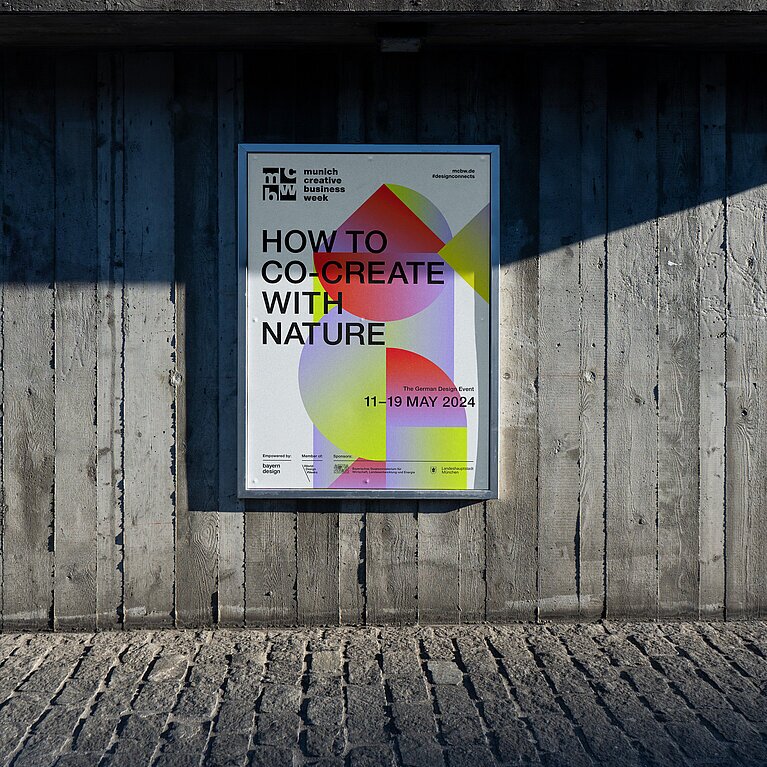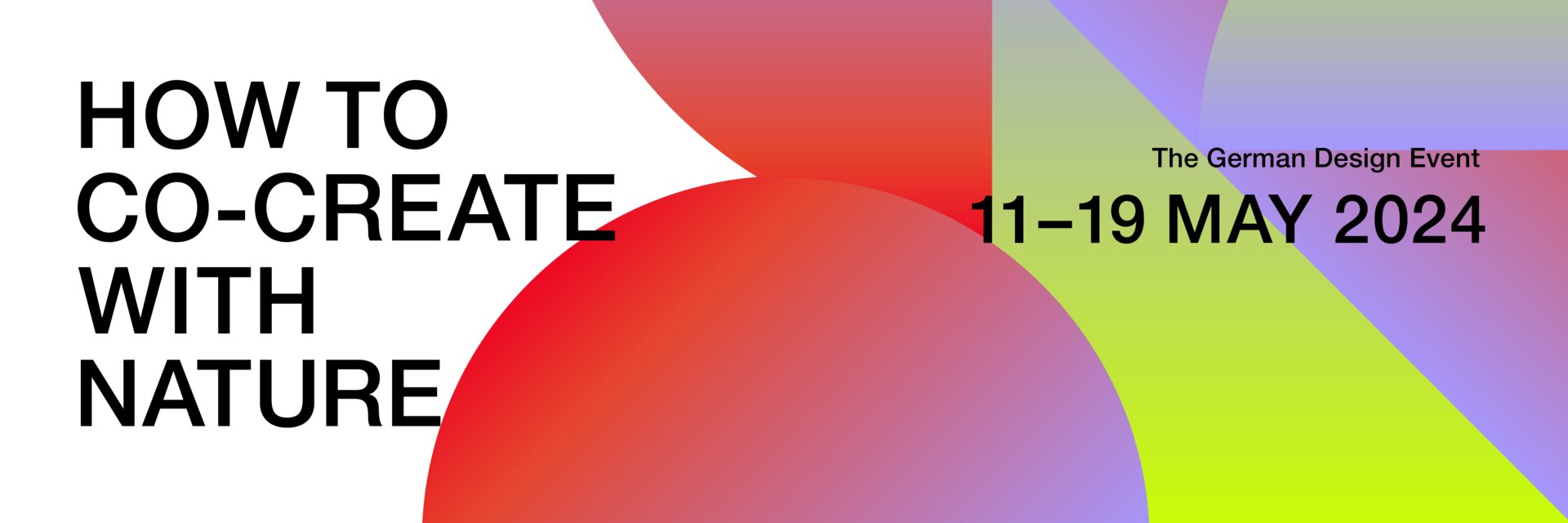

Together with our partners and other interested parties, we set out to explore the many ways in which design can help us (re-)learn how to work in partnership with nature, to accept it as a co-designer, and to live and grow side by side with it: collaboration instead of domination. To steer these reflections in a distinct direction, we have coined a tagline that sums up our concern and our mission for the future in a nutshell: "How to co-create with nature". Get in on this riveting discourse, as it's addressing the existential issue of how we can create a future that is worth living in.
In the history of our planet, the human species is a marginal note – in terms of time. In terms of its impact on the earth, however, things look quite different, as we can observe time and again in all kinds of natural phenomena across the globe. Naturally, all these events can also occur without human intervention. Just not with the same frequency and severity, as science claims. The evolution of humankind is inextricably linked to that of the Earth. Yet the living environments we design and produce are progressively alienating us from nature. In 2020, scientists at the Weizmann Institute of Science in Israel calculated the weight of anthropogenic mass - i.e., all man-made materials and structures such as steel, concrete, plastic or glass - at 1.1 tera tonnes. That put it on a par with biomass that year - and marked a tipping point. Because while the volume of biomass remains largely constant, the anthropogenic mass has been growing exponentially since man has been walking the Earth. Meanwhile, it exceeds the weight of all plants, animals, bacteria, etc.; researchers speak of a new age they call "Anthropocene".

The key tools for the development and production of anthropogenic mass have been, and still are, the inventive human genius and technologies. These in turn have caused our world to become more and more fragmented due to the progressive specialisation within the different fields and disciplines, making it ever more difficult to find overarching interconnections in our increasingly hyper-complex world. Accordingly, we perceive numerous recent developments as disruptive since they affect many areas of our lives and cause domino effects. We read about crises everywhere, though strictly speaking this isn't true in many cases. Because a crisis is a temporary occurrence, it usually passes at some point. Yet with regard to the so-called raw material, energy and climate crises, we have to assume for now that these will stick with us indefinitely: We have reached a point where the challenges our world is facing can hardly be solved the way we used to do it - i.e. using evolutionary, reproductive and optimising methods. We need to re-connect the fragments of our world to arrive at new insights and solutions. And nature and the way we engage with it appears to be particularly urgent and crucial in this endeavour.
It is high time to shift our understanding towards a holistic approach.
Nature is commonly defined as that which "is there" without any human intervention: rocks, streams, flora, fauna. This is, hence, an essentially material clarification of the term. Other voices claim, for example, that the sea in its present form (with its acidification, fish and coral stocks, changing gulf currents) has been at least partially shaped by man - as have the forests, mountainsides, etc. Conversely, nature can also be credited with creative power: All organisms are active and co-design their environment. And even the supposedly "dead material" such as sand, stones, rocks play a part in shaping our interaction with nature, resulting in utterly different cultural landscapes such as the Alpine valleys and the Sahara, to name two extremes. So, while human history oscillates between a glorifying understanding on the one hand (protect and preserve nature) and a combative relationship on the other (contain and dominate nature), it is high time to shift our understanding towards a holistic approach. Nature is the origin of all life, including the human species; it is the basis of our existence and our source of energy. Humans and nature are reciprocally interrelated: they are in a two-way dynamic of tension, and the boundaries are getting blurred. We now find ourselves on the threshold of a new era: We need to re-learn to cooperate with nature, to accept it as a co-designer and to live and grow side by side with it rather than trying to regulate it. Or in short: collaborate, not dominate.
We seek to open the space for stimulating insights, visions and approaches
This calls for creative minds that are used to thinking outside the box, taking unusual perspectives and asking disruptive questions. We must learn to comprehend nature in multiple roles: as teacher and beneficiary as well as co-designer and even the result of a design process. Also, our understanding of design needs to evolve (which is happening anyway): Going forward, we will design less things or spaces but shape more behaviour and processes instead, and we will formulate points of view to make our world a livable and sustainable place for all: people, flora, fauna. The mcbw 2024 is dedicated entirely to this theme: "How to co-create with nature". We seek to open the space for stimulating insights, visions and approaches - and to address designers, artists, architects, entrepreneurs, engineers, digital experts, scientists, sociologists, etc. in equal measure. Because we want to emphasise the "how": How can we learn from natural processes to develop more efficient and effective procedures? How can we think of solutions to protect nature (and people) in ways that also provide an attractive business model and thus have a broad impact? How can we use nature's creative power for collaborative innovations that benefit "both sides"? How can we permeate the boundaries between technology and nature and merge the two into new experiences? How can we, as designers, influence behaviour, processes and perceptions in a way that makes the majority see nature as a worthwhile objective - and basically the only relevant goal?




In accordance with these key questions, we have defined focus topics we wish to explore together with all partners and interested parties:
1. Re-Learn! Design approaches modelled on nature
Learning from nature isn't new: Humans have always used nature as an inspiration for new developments or have modelled them after nature. The history of engineering is filled with examples, starting with Leonardo Da Vinci. But it's time for us to take a closer look and learn: How, for example, does nature adapt to changing conditions? How does it "learn"? How does it communicate or exchange information? How does it distribute resources based on needs or targets? How does it create colour? Building on bionic approaches, we can learn a lot about solutions ("what") as well as processes ("how") and adopt concepts from the animal and plant kingdoms to further develop them with today's technology: from intelligent production (SKO / Soft Skill Option) to bacteria as energy storages.
2. Re-Generate! Design approaches for the benefit of nature (and mankind)
Climate neutrality is the talk of the town, climate positivity less so. Yet this is precisely the goal: Not only do we not take anything from nature, but ideally, we even give something to her. After all, preserving nature will only succeed if we also develop as many effective measures as possible to make a positive contribution (if only to compensate to some extent for the ongoing negative impacts). Circular economy is one of the key words here: processing and recycling resources that are already in circulation. We also need initiatives with an added value, such as search engines with linked reforestation projects or cycle paths that generate energy from sunlight. And we have to design services and communication in a way that they are sustainable in themselves and are also aimed at sustainability.
3. Co-Work! Design approaches in collaboration with nature
Nature is a multi-talented co-designer, if only we involve her properly. There are many examples in the crafts of indigenous peoples that can be translated into new procedures using current technologies. The fields of architecture and furnishing, for example, are the subject of extensive research. Spiders and caterpillars (to name just two) are innovative builders that can be involved in the construction of complex structures, and the same goes for trees (growing bridges). Fashion is another popular area of application for co-creation with nature - be it in terms of the materials themselves or the design (further processing of the garments, e.g., colouring by exposure to sunlight, etc.).
4. Un-Limit! Design approaches that merge nature and technology
The human species is yearning for natural, "real experiences" - it always has, and now more than ever in view of the advancing digitisation and virtualisation of our living environments. But the solution to this cannot (only) consist in going "back to nature", which in urban agglomerations alone hits against very tight limits. Today's art scene is designing interactive installations that explore the fusion of technology and nature and allow for immersive experiences. In addition, there are already more concrete approaches with economic use, such as data storage through plants or plant-based home automation. And some ideas and approaches are emerging under the rubric of Speculative Design or Future-Critical Design, especially in FabLabs, that aim at dissolving of the boundaries between technology and nature to induce a change in our thinking (AI tech wearables, for example).
Become part of mcbw 2024
You want to be part of the next mcbw? Register now for our partner dashboard or contact us via mail at contact @ mcbw.de to learn more about our mcbw event packages.

